Back in August, I was in a Hobby Lobby, dropping off some photo prints and frames for a project at work. The errand was not going as smoothly as I would have preferred; the employees were grumpy about how many prints needed to be framed, I was annoyed that I had to walk all the way to the back of the store just to get a cart to wheel the frames in myself, and, of course, it was raining.
I had to stand at the framing station for several minutes, hoisting the frames onto the counter and matching them with the appropriate prints, and as I stood there, the most unbelievable euphoria came over me. Suddenly, the world was ten times brighter, and I felt like I was floating on air.
I was aware of Coldplay’s classic song, “Clocks,” playing throughout the store, and in that moment, it was the most melodic, harmonious tune I’d ever heard. As I looked around at the Christmas decorations on display that late summer day, the Hobby Lobby seemed like the most amazing store I had ever set foot in. On the counter where the photo prints sat, I smiled at what looked like the most endearing photos I had ever seen.
This was my first Ironman-training-induced bout of euphoria. It was a high that didn’t last forever, but its occurrence was not by any means discreet. I had swam 2 hours, biked 4 hours, and run 3 hours all in the past couple of days, and the endorphins and adrenaline of those endeavors was hitting me in full force at the framing section of a craft shop. It was amazing.
The Ironman triathlon has always intrigued me. Although I was a late-blooming runner who didn’t compete in college, I had worked my way up to a marathon in my 20th year, the same year that I bought my first road bike and tackled my first triathlon—an Olympic distance event (0.9-mile swim, 24.8-mile bike, 6.2-mile run). I’ve always preferred running to the other disciplines, but I enjoyed the challenge of triathlon and how it was a lot easier on my body than just running every day.
After college, I trained for triathlons because I had access to a beautiful swimming pool, ample secondary highways for cycling, and endless gravel roads for running. Living in the upper Midwest, I considered tri’s to be summer-only pursuits, so I would train hard all summer, knock out a few Olympic tri’s (and even a couple of brutal half-Ironman races), and run a fall marathon—relying exclusively on a strong base of fitness, despite low running mileage. I would then retire my bike for the long winter off-season.
My Olympic tri’s improved,and I was fast enough to compete in the national championships three times. During those mid-20’s years, I also jumped headlong into the world of marathons,running one or two every year but struggling quite a bit with each one. Those long-distance events really beat me up, but I kept coming back for more.
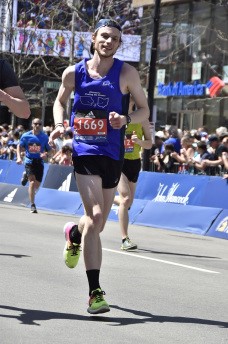
Over time, I met enough wise runners to gain a better sense of proper training strategies, including recovery, pacing, and nutrition. For a couple of years, my attention and passion was focused on the marathon, and by focusing for the first time on speed work, intentional recovery, easy runs, and tune-up races, I also crushed my 5k and half marathon PR’s. I even knocked out a 2:52marathon in 2016. That sub-3 time got me to Boston, where, in my seventh marathon, I finally fulfilled my lifelong dream of turning right on Hereford and left on Boylston, all the way to the most iconic finish line in road-running.
I was patient about signing up for an Ironman, and given my struggles in the half-Ironman races I had done,I knew I needed to respect the distance and the event enough to be smart about my preparation. I spoke with several coaches before choosing one who seemed to really understand my mindset as a runner. She, too, had a background in running, and she firmly believed that I could “earn my title” as an Ironman without sacrificing any of my running fitness or goals. Since she competes in Ironman races professionally, I knew she would be one to trust, and working with a coach (well, working with my coach) turned out to be the best decision I made in my quest to complete an Ironman.
I had swum 2.4 miles, biked 112 miles, and run 26.2 miles several times, but I had not yet strung all three of those disciplines together to take the Ironman plunge, and my two half-Ironman races had both been painful bonk-fests that left me feeling proud but defeated. With that said, my coach helped me hit the reset button on my mindset toward long-distance races, and we dove straight into training. From April through October, we did the obvious things: I increased my swimming, cycling, and running distances; I did a few tune-up races (including a huge half-Ironman PR); I improved my core strength; and I tried to stay on top of nagging injuries.
But during this time, I also tackled the things that made me uncomfortable and that were not much fun at first: I figured out my nutritional needs and became a chemist of sorts, measuring out milligrams of sodium, hourly caloric intake, etc.; I slowly developed a true friendship with my mechanically complicated bicycle; I practiced changing a bike tire enough times to feel comfortable with the process; I read about the psychological side of training and performing; and I put in a lot of lonely miles, especially on the bike—in the dark, in the cold, in the wind, and in the rain (but fortunately never all of those at once!).
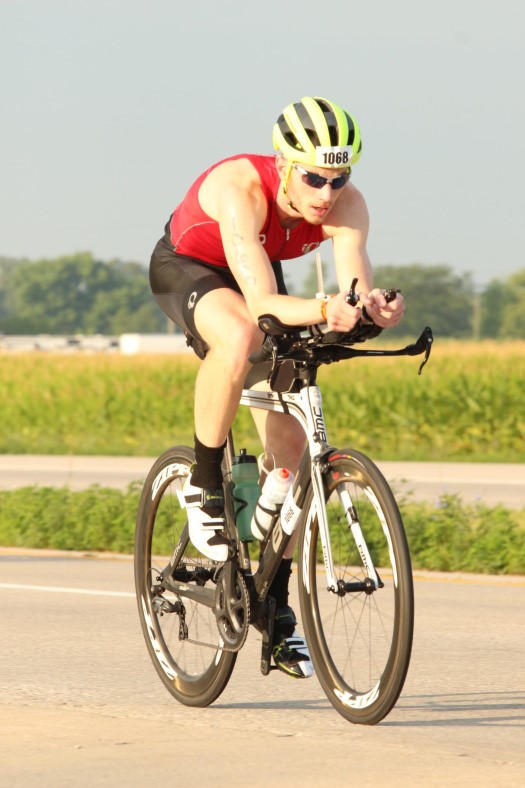
Throughout that process, I was well taken care of. I became a part of a team of athletes—all coached by the same person—(in addition to the fantastic team of runners I had already joined) who offered me more support and guidance than I could have ever hoped to have received from anyone. My coach’s husband gave me more than an hour of his evening on a weeknight just to show me how to set and adjust my rear wheel in my bike to feel comfortable and confident with its alignment. My teammates at a weekend training camp paused their ride for a couple of hours just to help me with a mechanical issue. One teammate straight-up gave me an extra wheel to take home with me; another teammate loaned me a pricey carbon bottle cage to use for my race.
My training for Ironman Louisville spanned more than six months. I eventually swam the full race distance a few times, I took a September trip to Louisville to bike the race course (and I also ran half of the marathon course), and I completed an 18-mile running day (sandwiched by multiple bike rides that totaled 70 miles for the day). With each workout, I practiced my nutrition and visualized my goal. I ate a lot, slept hard, and worried plenty, but I relied on my triathlon friends and support networks to keep me moving forward. To be honest, I loved the process.
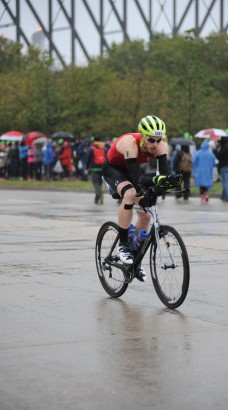
People who don’t do these things (so, like, 99% of the world) just don’t “get” it. I don’t say that as a judgment on anyone at all, but I learned very quickly that I had to be completely comfortable sticking to my own schedule and training plan without paying too much attention to what anyone else said or thought. This is where having a team and network of friends with similar goals really helped. I’ll never forget my August training camp, where, when riding my bike with a few other guys after a one-hour open-water swim, my rear brake clamped down on my wheel while I was climbing a monster hill. The other guys, not seeing my plight, descended down the hill, only to realize that I was nowhere in sight. My cabimate then turned around, re-climbed the hill, and came to my aid. We weren’t able to fix the issue, but he and the other cyclists halted their own ride just to try to help. And when I spent the next 4.5 hours riding on the stationary trainer while they finished their outdoor ride, they didn’t think I was crazy. They even grilled me a burger for dinner after I wrapped up my 7-hour training day with a 10-mile run (like I said, no one besides the people who share this interest with me can even fathom a day like that… so I just don’t tell most people!). Before being a part of a team, I never observed or experienced such a strong sense of selfless giving in triathlon training
My training for Ironman Louisville spanned more than six months. I eventually swam the full race distance a few times, I took a September trip to Louisville to bike the race course (and I also ran half of the marathon course), and I completed an 18-mile running day (sandwiched by multiple bike rides that totaled 70 miles for the day). With each workout, I practiced my nutrition and visualized my goal. I ate a lot, slept hard, and worried plenty, but I relied on my triathlon friends and support networks to keep me moving forward. To be honest, I loved the process.
People who don’t do these things (so, like, 99% of the world) just don’t “get” it. I don’t say that as a judgment on anyone at all, but I learned very quickly that I had to be completely comfortable sticking to my own schedule and training plan without paying too much attention to what anyone else said or thought. This is where having a team and network of friends with similar goals really helped. I’ll never forget my August training camp, where, when riding my bike with a few other guys after a one-hour open-water swim, my rear brake clamped down on my wheel while I was climbing a monster hill. The other guys, not seeing my plight, descended down the hill, only to realize that I was nowhere in sight. My cabin-mate then turned around, re-climbed the hill, and came to my aid. We weren’t able to fix the issue, but he and the other cyclists halted their own ride just to try to help. And when I spent the next 4.5 hours riding on the stationary trainer while they finished their outdoor ride, they didn’t think I was crazy. They even grilled me a burger for dinner after I wrapped up my 7-hour training day with a 10-mile run (like I said, no one besides the people who share this interest with me can even fathom a day like that… so I just don’t tell most people!). Before being a part of a team, I never observed or experienced such a strong sense of selfless giving in triathlon training….
I’m an Ironman!
This didn’t sink in for quite a few days after the race, and now that it finally has, I feel like I wear that title deep inside of me and carry it with me as I go about my post-race life. I’ve never been prouder of myself for a race effort before, because I have never been challenged so much by something that I had never expected to encounter—horrible weather conditions for hours on end—in a race before.
The night before the race, I was in bed shortly after 8 p.m., but I couldn’t fall asleep. Every time I started to drift off, my mind would start to think about swimming in a river—something I’ve never really done before, especially not in the most trafficked river in the United States. My heart would race and I would jolt awake. It was awful! I probably didn’t fall asleep until close to 11:30 p.m., and I was awakened by loud conversation right outside my door at 2 a.m., which I had to go into the hallway to address. So I probably slept from 11:15 p.m.–2 a.m., and then from 2:30-4:15 a.m. That wasn’t ideal, but I reminded myself that that sort of thing doesn’t really matter when the gun goes off on race day.
I got up at 4:15 a.m. and had plenty of time to put on my tri kit and extra layers and to arrange my bottle mixtures. I took my time forcing down a banana, some water, an electrolyte mix, and most of my peanut butter bagel. It was pouring outside, so I appreciated being able to sit in my hotel room and not having to rush outside just yet, but the rain had not stopped by the time I stepped out of the hotel.
My first stop was the bike transition area. I walked for 15 minutes in the rain to get there, and I chatted a little bit with another athlete. The temperature wasn’t too cold (upper 40’s), so I was pleased about that. I got my transition bags all set up and put my bottles on my bike. My bike neighbor let me borrow his air pump, which was great, except when filling my back tire, the tip of the tube’s valve popped off. That meant I couldn’t put any more air in, and the tube was only at 80 PSI, so I had to go to the mechanical tent for a new tube. This was the back wheel, which had been perfectly aligned to prevent the brake pad from rubbing the wheel rim, and I now wouldn’t be able to test out the new alignment, but at least the mechanic could help me out. My bike neighbor reminded me that I had plenty of time, so I stayed calm, racked my bike, and walked to the swim start.
With all the announcements and delays, I ended up standing in the swim start line for nearly 1.5 hours. Fortunately my family was there with me to hold my clothes bag and to retrieve an extra layer for me when the delay occurred, but I was still barefoot and shivering in a sleeveless wetsuit for much of that time. The announcement of the swim being shortened due to a strong current was a major bummer, but as everyone around me groaned, I immediately did a mental reset and took the issue in stride (after a teammate assured me that one can still “earn their title” in a shortened race). I moved forward in the line until I was away from some dudes who were being way too loud and profane for me to get into a good headspace. Then I focused on staying positive and mentally tough. It was going to be a long day, and I didn’t want to have a breakdown before even getting in the water.
SWIM (13:25) – 41st overall
I had trained to complete the 2.4-mile swim in under one hour, which is a strong time, but lots of overconfident people lined up in the sub-60 group. I tried to not let that bother me. And even though no one ever explained the new swim course directions at all, I managed to find my inner calm as the time trial starts began, and by the time I was on the dock, I was ready to swim.
I felt strong on the swim, and it was very easy. The current pushed us so hard, and I was able to breathe every 3-2-3-2 strokes. I had full range of motion in my shoulders and arms, thanks to my sleeveless wet-suit. I even stopped once to look around and get my bearings. I thought about pushing harder, but it seemed strange to do so in an Ironman swim. Given the short distance and insane current, I probably should have just gone harder; it wouldn’t have made much difference in my total time or exhaustion level, but I do think I could have been one of the top overall swimmers, to be honest. I held a ton back on that swim and still placed pretty well.
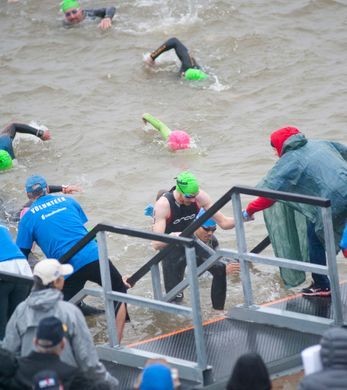
I didn’t have to deal with much physical contact with other swimmers, and I sighted the exit in time to pull away from the current. The dash to the change tent went smoothly, too, as I wasn’t out of breath or shaky at all. I had been in water that cold before, but never air temperatures that cold for a swim, and I had never swum in a downpour before, either. It all went fine when I was swimming, and my run to the change tent was steady. I wish we could have just swum the full distance.
Transition 1 – 9:18
I spent forever in the first transition (and even more in T2!), mainly because the change tent was packed, I needed help getting my wet-suit off, and it took a while to pull arm warmers and socks onto my wet body. The tent felt warm, but I didn’t realize that there were heaters in there, so I assumed the temperature had warmed up quite a bit outside. Because of this, I left my Hot Hands packets in my transition bag and ran out of the tent… straight into a cold downpour. At that point, though, I was focused on moving forward—there would be no backtracking.
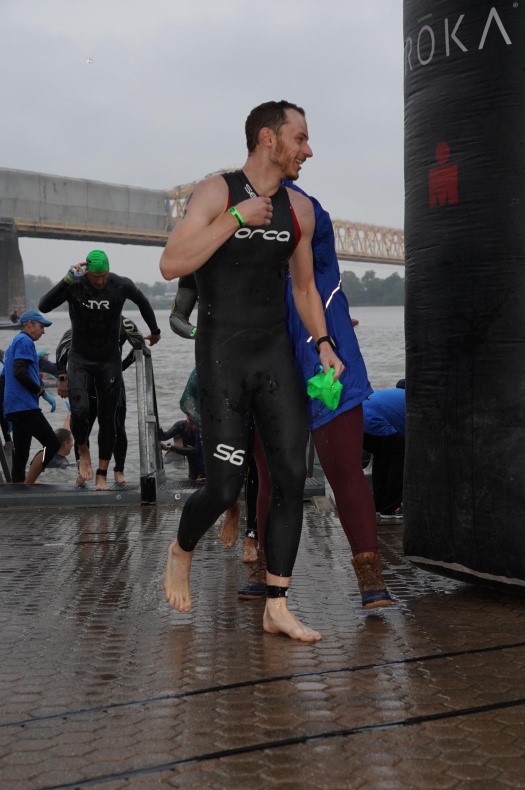
BIKE (6:13:39) – 430th overall
For the first 15 miles of the bike ride, I was completely shocked by how bad the conditions were. I was genuinely alarmed at how cold and wet I was, and how I couldn’t stop shivering. I had never ridden in such crappy conditions. I kept figuring it would get better the more I pedaled, and I was keeping up a decent clip, but I just couldn’t focus on anything related to heart rate or pace; all I could pay attention to was how my feet were soaked and completely numb, and how my torso was shivering.
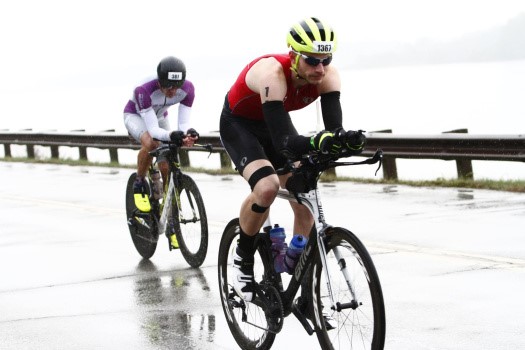
I couldn’t wait to get to the hills, because I knew those would get my heart rate up and warm my core a bit. So those climbs were nice. But for every up, there was a down, and this was a bad thing at IMLOU, because the faster I went downhill, the stronger the wind resistance against me was. I settled into a rhythm of warming up slightly while climbing hills at 12-15 mph, then cresting the hills all too soon, only to zoom down at 20+ mph, shivering uncontrollably as the wind hit me. I even used my brakes on some of the descents, at first because of safety concerns, but eventually because the cold of faster speeds was just too much for me. And it didn’t stop raining until I was well past the halfway point of the bike leg, which meant that for more than 60 miles I could never dry off, and therefore I could never warm up.
The drop-out rate on the bike was higher than it has ever been in the race’s history, and I saw dozens of people shivering on the side of the road, unable to continue due to hypothermia or simply being unable to operate their bikes with their frozen fingers anymore. Having never biked in those sorts of conditions—the perfect storm of cold temperatures and soaking wet conditions—I was under dressed and under prepared, but what I could do was control my attitude. I had prepared my mind to be ready for whatever race day brought, and on this particular day, the challenge was going to be staying mentally tough enough to keep moving forward and being optimistic in the face of conditions that truly had me wondering if I would be able to continue.
The bike leg was not just the most difficult bike ride of my life—it was the greatest mental challenge I have ever endured. Ever. Period. Like, nothing else comes close. I have never had to fight thoughts of quitting so hard. My body has never, ever, ever been that cold, including the five winters I have experienced in rural Iowa and in Sweden. As I sped down hills into the freezing wind, I exhaled heavily and audibly, over and over, trying to “breathe through the discomfort,” since I have used that technique to “breathe through” painful body work before. But the mental grind of having to start counting down time in my head, starting at six hours, was brutal. I tend to measure long lengths of time by how many Lord of the Rings movies I could watch in that time span, and I couldn’t fathom sitting through two of those epic flicks while being so cold and wet. Just six more hours of this… Only five more hours of this crap… Just four more hours to endure… Halfway through this misery!… Just stay tough for two more hours. Don’t quit now, Tim, you’re one hour away. I don’t think I’ll ever be able to adequately put into words just how deep I had to dig to push my mind and my body through that experience. It was something that no Ironman in training can ever predict, expect, or replicate. I don’t provide these descriptions to make excuses for myself (yes, I could have dressed differently and probably would have been much faster and more comfortable that day, so I can only blame myself for that), but so that I will always remember how I felt and responded in that situation.
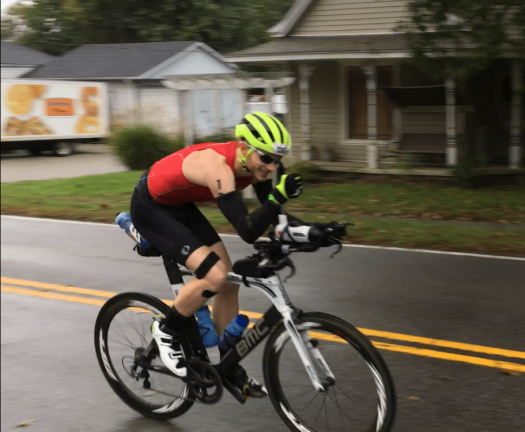
I knew that my family would be in La Grange, a small town where many of the middle miles took place, so I looked forward to seeing them and enjoyed those fly-bys so much. And for the final couple of hours of the ride, I warmed up ever so slightly. I still couldn’t feel my feet, and the shivering never stopped (Six. Freaking. Hours.), but I started to at least appreciate the course and look around a bit more. I had long since given up on worrying about pace; the name of the game had become not crashing, not dropping out, and not losing hope when I saw a few wrecks and dozens of dropouts. But I also saw countless amazing volunteers. They held my bike for me when I stopped to pee (3x… I was drinking plenty but not sweating at all), and they waited patiently while I slowly rearranged my water bottles.
My hands were mostly numb, so I couldn’t grip my bottles very well to sip, and I struggled to open my fig bars and Clif Gels, but I stuck to my nutrition plan, and energy was not an issue. However, my quads and calves started to feel crampy when I stood up out of the saddle to climb hills in the final 30ish miles of the race. That worried me, since I still had a long way to ride, but I just dropped back into the saddle and pushed onward in the aero position, since that didn’t bother my muscles as much. Again, pace was not on my mind pretty much from the very beginning, once I realized how close my body was to calling it quits and how bad the conditions were.
Transition 2 (13:28)
My T2 time was utter garbage, but it was the best I could do that day. I didn’t have much company in the change tent, so I had a volunteer all to myself, which was essential, because my fingers did not work. I needed help removing my shoes, socks, arm warmers, and tying my running shoes, etc. I pulled on dry gloves and a long-sleeved shirt and hit the road, but that whole process took forever.
RUN (3:39:51) – 245th overall
The run portion of an Ironman, unlike the bike leg, is not sexy.It can look awesome when set to music in a highlight video later on, but in real time, all runners look slow and awkward. The marathon run of an Ironman is gritty. It’s raw. The anguish that is normally reserved for the final 6 miles of a standalone marathon hits about 15 miles sooner in an Ironman. But with that said, I had never been so happy about starting a marathon. My feet quickly came back to life, my heart rate climbed a bit, and I could just be in my favorite, most familiar element. I also didn’t feel any leg cramps for the entire marathon, which I was shocked and thrilled about.

The beginning of the marathon was kind of funny, because there was no start line or fanfare of any sort. It was simply me starting a 26.2-mile run in the middle of the afternoon without much company. The plan had been to hit 8:30s for the first two miles, then gradually drop down toward 8-8:15s, and although I didn’t have trouble with those 8:30s, I could also tell that 8:00 pace was not going to be in the cards. My body had simply worn itself down on the bike and by shivering to keep warm for so many hours. Nonetheless, my run splits were super consistent; in fact, although this was my eighth slowest marathon time out of the nine I’ve run, it was definitely my most consistent one:
Miles 1-6 — 8:16, 8:36, 8:33, 8:16, 8:17, 8:10
Miles 7-12 — 8:12, 9:06 (pee break), 8:30, 8:27, 8:27, 8:35
Miles 13-18 — 8:37, 8:32, 8:42, 8:29, 8:25, 8:34
Miles 19-24 — 8:27, 8:28, 8:32, 8:36, 8:28, 8:35
Miles 25-26 — 8:34, 7:54
If I did the math correctly on those splits, I ran the first 13 miles within 14 seconds of my time for the final 13 miles.
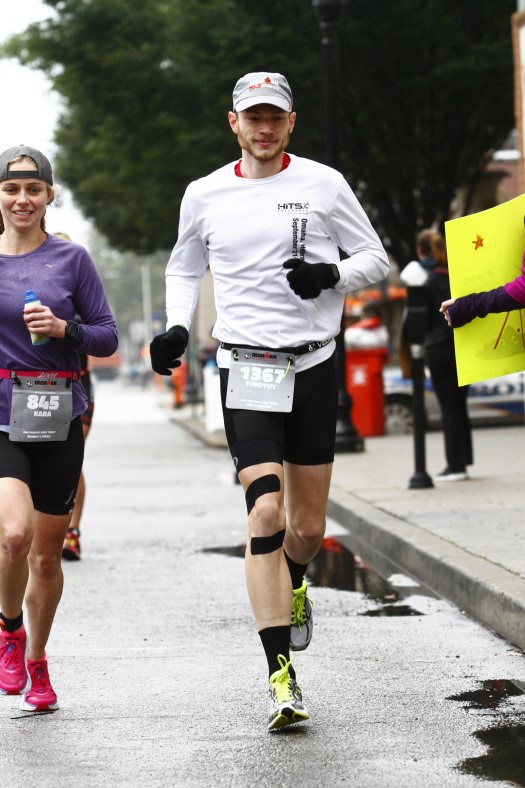
I stuck to my nutrition plan, and it was just right as far as salt goes. I took a lick or two of Base Salt every single mile, just before the aid stations, where I would take a swallow of water (every mile) and Gatorade (every two miles). I also had two gels during each of the first two hours. I had to force the final gel down, but I got it in. I also had a couple bites of banana on two occasions during the first 13.1 miles, since I started to feel hungry (all the shivering had burned off more calories than my initial nutrition plan had accounted for).
I was happy to be running, but after the exhilaration of seeing family members and friends during the first four miles or so had passed, I started to feel pretty low. I was warm enough to shed my gloves and ditch my sleeves, so the temperature was fine, but I could tell that I was dragging myself along, and I felt the way I normally do much later in a marathon… Miles 5-12ish were pretty rough, and I was not feeling ready for all the miles ahead of me, but I stood tall, stayed focused, and told myself I’d keep it up for as long as I could.
Although I’ve never had flat cola in a race, I felt like giving it a shot early in the marathon, because I was feeling so low. But I held myself back until the halfway point, which was good timing, because by mile 12, I was so over Gatorade that I couldn’t take another sip of the stuff. So after the adrenaline rush of passing by the finish line and more fans (the run is a two-loop course that goes right by the finish line at the end of the first loop), I took a sip of cola at mile 13.
I felt better for the second half of the race than I did for the first. The cola worked some magic for me, and I only skipped it at one aid station. Otherwise, I focused on also getting water every mile, taking one 33-calorie Clif Blok every 10 minutes, and taking Base Salt every mile. I was dialed in on the routine, and I enjoyed seeing a few other athletes I knew on the course and engaging with the fantastic volunteers, one of whom opened my Clif Bloks for me, since I was struggling to do it myself. I didn’t cramp up, and I settled into a rhythm. My family members who saw me at miles 4, 9, 16, and the finish said that I looked my worst at mile 9, but after that they saw a change come over me, for the better.
I was still in quite a bit of discomfort, but it was the usual marathon discomfort—not knee pain, cramping, or digestive issues—which, to an experienced runner, is pretty routine and familiar. I started to think a familiar thought from all my other marathons: just run as far as you possibly can before you walk, because as soon as you walk once, you’ll probably keep taking walking breaks until the finish. Fortunately, that did not come to pass. Although I would stop running for a second or two to grab water and cola at the aid stations in the final half, it was just because I didn’t want to spill my life-giving elixirs; I did not stop to take a break from the effort, and I also didn’t have a ton of trouble getting going again after each aid station. I ran the most honest second half of a marathon that I ever have—never relenting, never lying to myself about why I might need to ease up on the gas. I just kept running (and eating, and drinking).
It was such a gratifying feeling to be able to run through the dreaded miles—21, 22, 23, 24—without needing to stop. I just kept plugging along, running somewhat scared because I knew my coach, who was also competing, was close behind and probably using her extensive race experience to kick like crazy. I had seen her several times on the course, including around mile 20 as she was on the other side of the road, and she had made sure to remind me that, “Everyone is hurting… Keep pushing.” I did not want to have to walk, but I especially didn’t want her to see me walk, if I did!
All throughout the marathon, thoughts of the finish line came to mind, but I was very successful at blocking those thoughts out immediately anytime they popped up. I knew the day was just too long for me to start dreaming of the finish line before it was imminent. Even passing so close to the finish line as I started my second loop hadn’t been too bad—I’ve never struggled too much with running by the finish or “home” during a tough training run, because no matter what I see, I know that I am still making forward progress toward the end goal. But after completing mile 24, I finally let myself look forward to the finish line for the first time. Knowing that my family, friends, and the red carpet of the finisher’s chute were all within reach, the tears started to flow.
Once I finished mile 25, I knew that not only was I going to make it, but I was going to feel pretty good in the home stretch. I ditched whatever Base Salt and leftover Bloks I had left and focused on the final mile. This part was everything I had ever dreamed of for my first Ironman race: not just finishing it, but being able to push, push, push the last bit and finish with a smile. I picked up the pace and ran my fastest mile of the day, going sub-8:00 for the 26th mile.
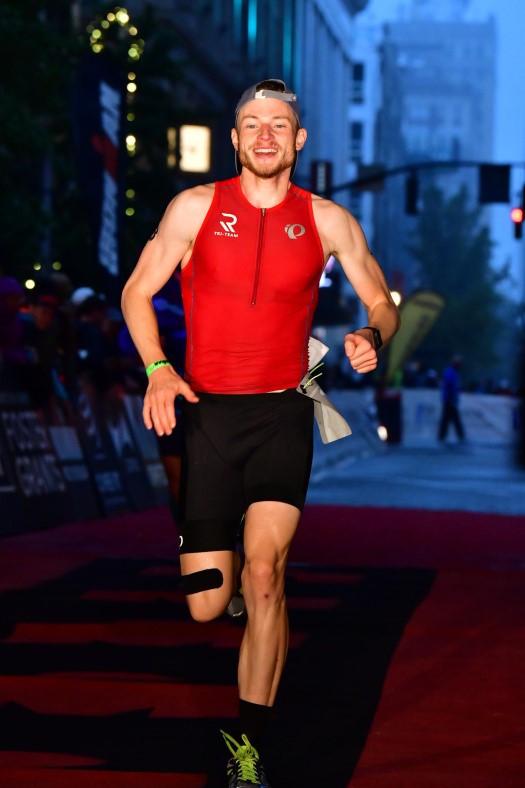
I saw my sister at the corner of the final turn, and I asked her if it was the last turn to the finish. She said it was, and I grinned from ear to ear. A very small part of me was almost sad that the experience was nearly over, because I was so pleased with how the run was going, but a bigger part of me was ready to crush that finish line, so I sprinted for the finish. I hadn’t allowed myself to go all-out in that last mile, because I didn’t want to risk cramping up, but I held nothing back in the home stretch. It was long enough that I could really soak it all in, and I made sure to appreciate that red carpet, listen to the crowd, and pass the one guy who was ahead of me in the final straightaway. There was no pain, no gasping… just exhilaration.
OVERALL (10:29:41) – 245th overall
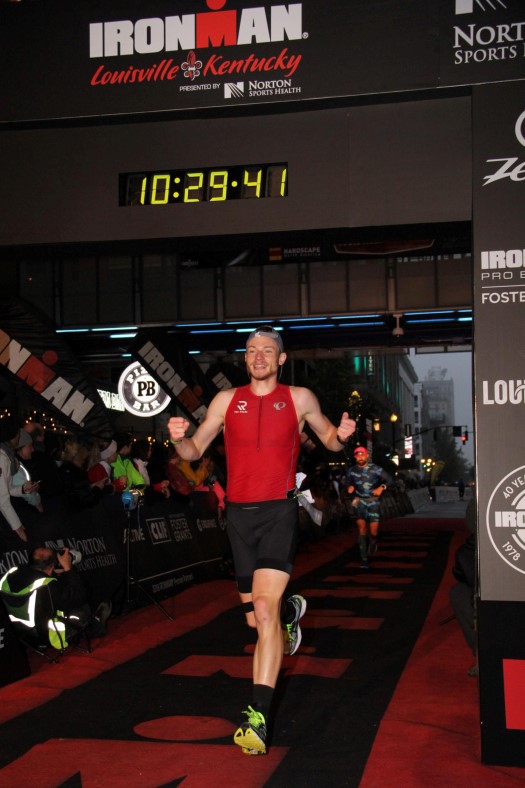
The weather threw a wrench in just about everything at this race, but I stuck to my nutrition plan and experienced an enormous confidence boost by running what I would consider my best-executed marathon ever, even after getting my butt kicked for 6+ hours before the run even began. I was also so grateful to have done some mental prep for the race, because I needed to focus so hard on adapting to the realities of the day and staying in the present.
I loved spending a few hours at the finish line after taking a hot shower and putting on dry clothes. I had left my medal and race number in my hotel room, so I blended in with all the spectators. I felt incognito, but I also knew that I was carrying an enormous accomplishment inside me—one that could never be taken away from me and that would always be a part of me, whether other people knew it or not. This is why—at least for now—I don’t think I need a tattoo for this accomplishment (getting an Ironman tattoo is sort of a thing for some people), because I’ll always have that pride inside of me, and a logo just can’t tell the full story of what IMLOU 2018 was like. I think that race will be something that only my fellow competitors (and the slim 60% of the field that even finished) and I will ever fully understand, and I’m okay with that. It’s my life to live, after all, and I feel like I have this super power deep inside of me now.
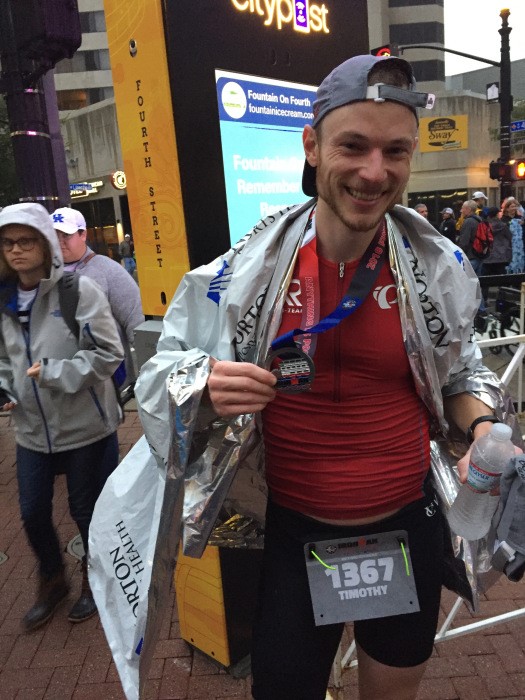
I’ll always carry this experience with me. The training was tough, and most days I felt like I was just trying to hold my body together, but I survived the buildup (with a strong Olympic triathlon and a huge 70.3 PR along the way) and performed on race day in horrible conditions. Yes, the cool weather probably helped me out during the run, and I might have had different issues in warmer weather. But a challenge is a challenge, and I know that I overcame a big one in Louisville.
Now that a few weeks have passed, my mind is already considering future races, because not only would I like to see what I can do in a full-length swim and when I can actually focus on a competitive strategy on the bike, but because I’d like to race in the sunshine for at least a few hours. I think I could have a lot more fun, in addition to feeling the pride I feel from this one, at a future Ironman race. In fact, I already have a date on the calendar.
But for now, I am content and so, so grateful to everyone who made this accomplishment possible. I owe countless friends, family members, and teammates a debt of gratitude for their patience, support, and encouragement.


